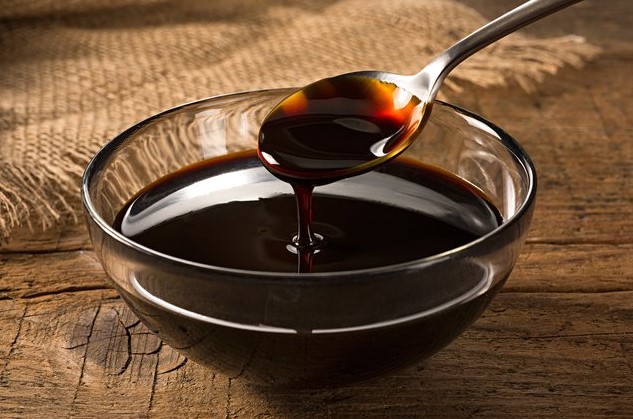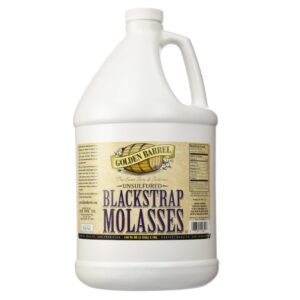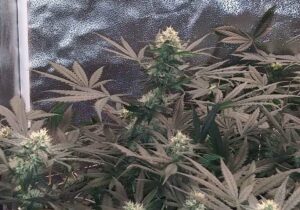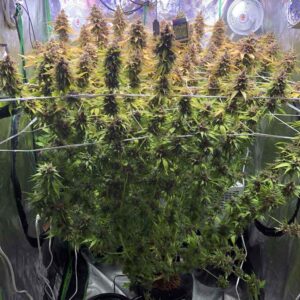Molasses as a Fertilizer
Table of Contents
- Introduction
- The Natural Advantage of Organic Supplements
- Understanding Molasses: A Potent Fertilizer
- 3.1 Types of Molasses: Choosing the Right One
- 3.2 Nutrient Profile: The Powerhouse of Plant Nutrition
- Timing Matters: Optimizing Molasses Usage in Late Flowering
- Feeding Your Cannabis: How to use Molasses as a Fertilizer
- 5.1 Dosage Guidelines: Feeding Chart and Finding the Right Balance
- 5.2 Frequency Optimization: Tailoring Molasses Feeding to Growth Stages
- 5.3 Application Methods: Soil vs. Foliar Feeding
- Debunking Myths: Bigger Buds and Increased Trichomes
- 6.1 Genetic Influence on Bud Development
- 6.2 The Role of Light, Nutrients, and Environmental Factors
- Sweet Alternatives: Exploring Sugar Supplements
- 7.1 Comparing Molasses, Honey, Corn Syrup, and Agave Nectar
- 7.2 Choosing the Best Sugar for Cannabis Cultivation
- The Sweet Finish: Molasses Flush for Enhanced Aroma and Taste
- 8.1 The Science Behind Molasses Flush
- 8.2 How to Perform a Molasses Flush: Step-by-Step Guide
- Conclusion: Mastering Molasses for Optimal Cannabis Growth
1. Introduction
In the ever-evolving world of cannabis cultivation, natural supplements have become the cornerstone of healthy and sustainable growth. Among these, molasses as a fertilizer stands out as a secret weapon, offering a plethora of benefits for cannabis plants. In this comprehensive guide, we will unravel the mysteries of molasses, exploring its various applications and debunking myths, ultimately empowering growers to optimize their cannabis cultivation practices.
2. The Natural Advantage of Organic Supplements
Modern cannabis cultivation is witnessing a paradigm shift towards organic additives, aligning with the principles of sustainable and eco-friendly practices. Molasses, a natural byproduct of sugar production, epitomizes this trend. Its rich nutrient profile and ability to enhance soil microbiology create an environment where cannabis plants flourish naturally. By promoting the growth of beneficial microorganisms and aiding nutrient uptake, molasses fosters a holistic ecosystem, resulting in robust cannabis plants.
3. Understanding Molasses: A Potent Fertilizer
3.1 Types of Molasses: Choosing the Right One
Before delving into the world of molasses application, it’s essential to understand the different types available and their distinct characteristics. Light molasses, derived from the first boiling of sugar cane or sugar beet juice, boasts a mild sweetness and light amber color. Dark molasses, a product of the second boiling, offers a stronger flavor and a darker hue. However, the true powerhouse in the molasses family is blackstrap molasses, a result of the third boiling. It stands as the most concentrated and nutrient-rich form, characterized by its bitter flavor and dark color.
3.2 Nutrient Profile: The Powerhouse of Plant Nutrition
The magic of molasses lies in its intricate nutrient composition. Rich in carbohydrates, primarily sucrose, glucose, and fructose, molasses serves as an energy source for the beneficial microbes residing in the soil. These sugars fuel the microbial activity, enhancing soil structure, nutrient availability, and supporting overall plant development.
Additionally, molasses is a treasure trove of essential minerals such as potassium, calcium, magnesium, and iron. Potassium plays a pivotal role in regulating water balance, nutrient transport, and enzyme activity within plants. Calcium contributes to cell wall development and enzymatic processes, while magnesium is a core component of chlorophyll, crucial for photosynthesis. Iron, another vital mineral found in molasses, participates in various enzymatic and respiratory processes, ensuring the overall health of cannabis plants.
Moreover, blackstrap molasses contains essential vitamins, including B6 and niacin. These vitamins play a significant role in plant metabolism, enzyme activity, and enhance the growth of beneficial soil bacteria. Therefore, incorporating molasses into cannabis cultivation not only provides an energy source but also enriches the soil with a myriad of nutrients essential for robust plant growth.
4. Timing Matters: Optimizing Molasses Usage in Late Flowering
The late flowering stage in the cannabis growth cycle is a critical period. It’s during this phase that buds mature, and the development of taste and aroma becomes paramount for growers aiming for top-quality yields. Molasses, with its diverse nutrient content, becomes a valuable ally during this stage.
The application of molasses in the late flowering period serves multiple purposes. Firstly, it provides an additional nutrient boost to the plants when they need it the most, ensuring the development of healthy, flavorful buds. Secondly, molasses acts as a catalyst for enhancing the terpene profile of the cannabis flowers. Terpenes are organic compounds responsible for the aroma and flavor of cannabis strains. By using molasses strategically, growers can influence the terpene production, resulting in a more aromatic and flavorful end product.
5. Feeding Your Cannabis: How to use Molasses as a Fertilizer
Molasses Application Chart: Weeks and Dosage
| Weeks | Growth Stage | Dosage for Soil Drenching (per gallon of water) | Dosage for Foliar Feeding (per gallon of water) |
|---|---|---|---|
| 1-2 | Germination & Seedling | Not recommended | Not recommended |
| 3-4 | Early Vegetative | 1 tablespoons | Not recommended |
| 5-6 | Mid-Vegetative | 1 tablespoon | Not recommended |
| 7-8 | Late Vegetative | 1 to 2 tablespoons | Not recommended |
| 9-10 | Early Flowering | 3 tablespoons | 1 tablespoon (leaves only) |
| 11-12 | Mid-Flowering | 3.5 tablespoons | 1.5 tablespoons (leaves only) |
| 13-14 | Late Flowering | 4 tablespoons | 2 tablespoons (leaves only) |
| 15+ | Ripening/Harvest | Molasses Flush (1-2 tablespoons) | Not recommended |
Notes:
- For soil drenching, mix the specified amount of molasses with one gallon of lukewarm water. Stir well to ensure complete dissolution.
- For foliar feeding, the ratio indicates the amount of molasses to be mixed with one gallon of water. Use a sprayer to apply the solution directly onto the leaves. Perform foliar feeding early in the day to allow leaves to dry before nightfall and minimize the risk of mold or mildew.
5.1 Dosage Guidelines: Finding the Right Balance
Achieving the optimal dosage of molasses is crucial to harness its benefits without overwhelming the plants. A general guideline is to use 1 to 3 tablespoons of molasses per gallon of water or fertilizer solution. This dosage range allows flexibility, enabling growers to tailor their approach based on the specific needs of their cannabis plants and the growth stage they are in.
It’s advisable to start with the lower end of the dosage spectrum, especially if you are new to molasses application. Observing the plant’s response is essential; signs of nutrient burn or stress indicate an excess dosage. Careful monitoring enables growers to make necessary adjustments, ensuring the plants receive the right amount of molasses for optimal growth.
5.2 Frequency Optimization: Tailoring Molasses Feeding to Growth Stages
The frequency of molasses application varies throughout the cannabis growth cycle. During the vegetative stage, applying molasses every 2 to 3 weeks is generally sufficient. As the plants transition into the flowering stage, particularly during the late flowering phase, increasing the frequency becomes beneficial. This period of accelerated bud development demands additional nutrients, and molasses provides a natural and organic source of essential elements.
Observing the plants closely is the key to determining the ideal frequency. Healthy, vibrant growth indicates that the plants are receiving adequate nutrients. However, if any signs of stress or deficiencies appear, adjusting the molasses application frequency becomes imperative. Over-feeding can be as detrimental as under-feeding, emphasizing the importance of a balanced and attentive approach.
5.3 Application Methods: Soil vs. Foliar Feeding
Molasses can be applied to cannabis plants through various methods, each with its unique advantages. One common approach is to mix molasses directly into the soil or growing medium. When incorporated into the soil, molasses becomes a steady source of nutrients for the plants and the soil microbiome. This method ensures a gradual and consistent release of nutrients, supporting the long-term health and vitality of the cannabis plants.
Another application method gaining popularity among growers is foliar feeding. Foliar feeding involves spraying a diluted molasses solution directly onto the leaves of the cannabis plants. This method offers rapid nutrient absorption through the foliage, bypassing the root system. Foliar feeding is particularly useful when the plants require immediate nutrient uptake or when there are issues with the root system that hinder nutrient absorption.
However, it’s essential to exercise caution when using foliar feeding, as excessive moisture on the leaves can create a favorable environment for mold and mildew. Therefore, growers opting for foliar feeding should do so early in the day, allowing the leaves ample time to dry before nightfall. Additionally, ensuring proper ventilation and airflow around the plants reduces the risk of moisture-related problems.
6. Debunking Myths: Bigger Buds and Increased Trichomes
Growing cannabis with large, resinous buds and abundant trichomes is a goal for many cultivators. While molasses as a fertilizer contributes significantly to overall plant health, it’s essential to dispel common myths surrounding its direct impact on bud size and trichome production.
6.1 Genetic Influence on Bud Development
Genetics play a fundamental role in determining the size and structure of cannabis buds. Each cannabis strain has unique genetic traits that influence its morphology, including bud density and trichome production. Experienced breeders select and cultivate strains with desirable traits, including large buds and high trichome yields. Therefore, choosing the right cannabis strain is a pivotal factor in achieving impressive buds and abundant trichomes.
6.2 The Role of Light, Nutrients, and Environmental Factors
Proper lighting is a cornerstone of successful cannabis cultivation. Light intensity, spectrum, and duration significantly influence bud development and trichome production. Cannabis plants require specific light spectrums during different growth stages. Providing the appropriate spectrum and intensity of light ensures optimal photosynthesis and metabolic processes, contributing to healthy bud formation and trichome production.
Nutrient management is another crucial aspect of cannabis cultivation. Balanced nutrient solutions, including macronutrients (nitrogen, phosphorus, potassium) and micronutrients (such as calcium, magnesium, and iron), are essential for robust plant growth. Deficiencies or imbalances in nutrients can hinder bud development and trichome production. Therefore, maintaining a well-rounded and carefully monitored nutrient program is imperative.
Environmental factors, including temperature, humidity, and airflow, also impact bud size and trichome production. Cannabis plants thrive within specific temperature and humidity ranges. Adequate airflow prevents stagnant air and promotes healthy transpiration, ensuring efficient nutrient uptake. Proper ventilation and air circulation within the growing space contribute to optimal environmental conditions, supporting vigorous bud growth and trichome development.
Additionally, growers can implement various cultivation techniques to maximize bud development. Techniques such as pruning, topping, low-stress training (LST), and the Screen of Green (SCROG) method help distribute light evenly, increase air circulation, and promote bud sites, leading to larger, denser buds and enhanced trichome production.
In summary, while molasses significantly contributes to overall plant health, achieving sizable buds and abundant trichomes requires a holistic approach. Genetics, lighting, balanced nutrients, and optimal environmental conditions, coupled with strategic cultivation techniques, collectively influence the final yield and quality of cannabis buds.
7. Sweet Molasses Alternatives: Exploring Sugar Supplements
7.1 Comparing Molasses, Honey, Corn Syrup, and Agave Nectar
While molasses as a fertilizer remains the preferred choice for cannabis cultivation, exploring other sugar supplements provides valuable insights into alternative options.
Molasses: As discussed, molasses is a nutrient-rich byproduct of sugar production, offering a wide array of minerals and vitamins essential for plant growth.
Honey: Honey, a natural sugar source primarily composed of fructose and glucose, can serve as a mild alternative to molasses. To prepare a honey solution, mix one tablespoon of organic honey in a gallon of lukewarm water. Stir gently until the honey dissolves completely. Honey provides some nutrients and encourages beneficial microbial activity in the soil.
Corn Syrup: Corn syrup, a highly processed sugar source primarily composed of glucose, can provide energy to soil microbes. However, it lacks the diverse nutrient content found in molasses, making it a less comprehensive option for cannabis cultivation.
Agave Nectar: Agave nectar contains fructose, sucrose, and glucose, offering a mix of sugars for plant energy. While it provides some benefits, it lacks the mineral content present in molasses, making it a less potent choice in terms of nutrient supplementation.
7.2 Choosing the Best Sugar for Cannabis Cultivation
When comparing these sugar sources, molasses stands out as the most promising product for cannabis cultivation due to its diverse sugar content and rich nutrient profile. While honey, corn syrup, and agave nectar can offer some benefits, they don’t provide the same level of nutrients and minerals as molasses.
It’s important to remember that using sugar supplements in cannabis cultivation should be done in moderation and as part of a well-rounded nutrient program. While sugars provide energy for beneficial microbes and support plant development, they should complement a comprehensive and balanced nutrient regimen tailored to the specific needs of the cannabis plants.
8. The Sweet Finish: Molasses Flush for Enhanced Aroma and Taste
8.1 The Science Behind Molasses Flush
As cannabis plants approach the harvest stage, growers can employ a technique known as a molasses flush to enhance the aroma and taste of the buds. The concept behind a molasses flush involves using a molasses solution to remove excess nutrients and salts from the growing medium. By breaking down these compounds and enhancing the root environment, cannabis plants can efficiently absorb nutrients, resulting in improved terpene production.
Terpenes, the aromatic compounds found in cannabis, contribute to the distinct flavors and fragrances of different strains. Enhancing terpene production not only enriches the sensory experience but also adds value to the final product. The molasses flush process optimizes the terpene profile, creating a more complex and enticing aroma and taste in the harvested cannabis buds.
8.2 How to Perform a Molasses Flush: Step-by-Step Guide
Performing a molasses flush is a simple yet effective process that requires careful attention to detail. Follow these steps to conduct a successful molasses flush in the final weeks before harvest:
Materials Needed:
- Blackstrap molasses (unsulfured) – 1 to 2 tablespoons per gallon of water
- Clean water
- Watering can or spray bottle
- pH meter (optional)
Steps:
- Prepare the Molasses Solution:
- In a clean container, mix 1 to 2 tablespoons of blackstrap molasses per gallon of water. Stir well until the molasses is thoroughly dissolved.
- Adjust the pH (Optional):
- Use a pH meter to check the pH of the molasses solution. Ideally, the pH should be within the range of 6.0 to 6.5. Adjust the pH if necessary using pH up or pH down solutions.
- Water the Plants:
- Use the molasses solution to water the cannabis plants during the last two weeks before harvest. Ensure even distribution of the solution throughout the growing medium.
- Monitor Absorption:
- Observe the plants for signs of nutrient deficiency or excess. Adjust the molasses solution’s frequency or concentration if any issues arise.
- Harvest at the Peak:
- With the molasses flush completed, the cannabis plants are primed for harvest. The enhanced terpene production contributes to a superior aroma and taste in the harvested buds.
By following this step-by-step guide, growers can capitalize on the molasses flush technique, enhancing the quality and sensory appeal of their cannabis harvest.
9. Conclusion: Mastering Molasses as a Fertilizer
In conclusion, molasses as a fertilizer stands as a testament to the wonders of natural supplementation in cannabis cultivation. Its intricate nutrient profile, coupled with its ability to enhance soil microbiology and terpene production, makes it an indispensable tool in the hands of discerning growers. By understanding the diverse applications of molasses, from early growth stages to the final flush before harvest, cultivators can harness its potential to achieve exceptional yields and superior-quality cannabis buds.
Embracing the art of molasses application requires a balance of knowledge, observation, and intuition. By tailoring molasses dosage, frequency, and application methods to the specific needs of the cannabis plants, growers can create an environment where plants thrive naturally. Moreover, the molasses flush technique adds a nuanced dimension to the cultivation process, elevating the sensory experience for consumers and cultivators alike.
As growers embark on their journey to master molasses application, it’s essential to embrace the symbiotic relationship between nature and cultivation. Molasses, with its sweet allure, not only nurtures cannabis plants but also enriches the very essence of the final product. By integrating molasses into their cultivation practices, growers unlock the full potential of their cannabis crops, cultivating not just plants, but a sensory masterpiece crafted by nature’s sweet secret.





